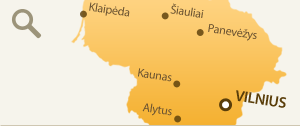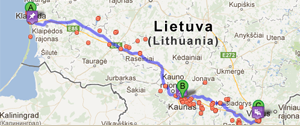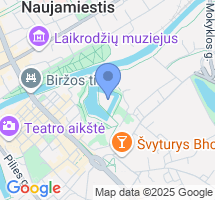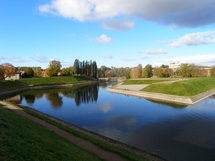Jonas hill and the Citys Bastion Fortifications
Under the guidance of the engineer Charles Rose, the city was begun to be encircled in the manner of Holland-type fortifications, eastward from the former St. Johns church. Moulds and bastions measuring about 3.5 meters high were formed, and outer ditches (fosses) were dug. Because of their size, the city fortifications are categorized as being amongst the great royal castles. The works were finished in only the late 17th century-early 18th century. Later, the moulds were reconstructed in the mid-18th century. The fortification system of Klaipėda at that time was complex. Because the city was surrounded with bastion fortifications from the East and South, and secured by the Naujoji Danė River from the North, the only access was via three gates: named after their objects - Tiltas (Bridge), Kūlių (of Stones), and Malūnų (of the Mills). The latter two were built upon earthen ramparts.
During the wars in the 18th century, the maintenance of the fortress was neglected, the gateways were begun to be disassembled for their bricks, ramparts were torn-up, ditches were filled with soil, and in the 20th century only small fragments of the former complex fortification system remained.
Today, the former fortification system can be best observed at the end of Turgaus Street, from the bastions referred to in the historical records as the Geldern and Purmark. In front of the bastions can be seen the water-area of the defensive ditch/Foss, and the only surviving ravelin. The remains of these defensive fortifications were restored (author of project V. Šliogeris) in 1994-1997.
More information: http://www.klaipedainfo.lt
Nearby objects
 Nuomojame nuo balandžio15d. iki spalio 15d, kaina asmeniui 30-40 Lt. (~6.4 km)
Nuomojame nuo balandžio15d. iki spalio 15d, kaina asmeniui 30-40 Lt. (~6.4 km) Horsemarket jojimo paslaugų centras – puiki vieta mėgstantiems žirgus, gamtą ir geras emocijas. (~12.5 km)
Horsemarket jojimo paslaugų centras – puiki vieta mėgstantiems žirgus, gamtą ir geras emocijas. (~12.5 km) Vieno kambario apartamentų nuoma Palangoje vos už 50 Lt. parai (~23.7 km)
Vieno kambario apartamentų nuoma Palangoje vos už 50 Lt. parai (~23.7 km) Viešbutis, restoranas, mini SPA, vyno rūsys, konferencijų salė. (~126.1 km)
Viešbutis, restoranas, mini SPA, vyno rūsys, konferencijų salė. (~126.1 km) Šiaurės Lietuvoje, 28 km nuo Šiaulių, 5 km nuo Radviliškio, 49 km nuo Panevėžio, pakeliui į Tytuvėnus ir Raseinius, miškų apsuptyje, kur… (~151.4 km)
Šiaurės Lietuvoje, 28 km nuo Šiaulių, 5 km nuo Radviliškio, 49 km nuo Panevėžio, pakeliui į Tytuvėnus ir Raseinius, miškų apsuptyje, kur… (~151.4 km) Niekada negali žinoti ar tau patiks, kol pats neišbandai naujos pramogos. (~195.1 km)
Niekada negali žinoti ar tau patiks, kol pats neišbandai naujos pramogos. (~195.1 km) Viešbutis „Metropolis“, garsėjantis įspūdinga istorija, yra vienas iš labiausiai žinomų viešbučių Lietuvoje (~197.6 km)
Viešbutis „Metropolis“, garsėjantis įspūdinga istorija, yra vienas iš labiausiai žinomų viešbučių Lietuvoje (~197.6 km) Viešbutis – Restoranas „Sfinksas“ įsikūręs ramiame, netoli miesto centro esančiame kampelyje. Ramybė, aukštas aptarnavimo lygis, jaukumas –… (~198.5 km)
Viešbutis – Restoranas „Sfinksas“ įsikūręs ramiame, netoli miesto centro esančiame kampelyje. Ramybė, aukštas aptarnavimo lygis, jaukumas –… (~198.5 km) Conviva -nedidelis, jaukus 3 žvaigždučių viešbutis pačiame Panevėžio miesto centre. (~202.1 km)
Conviva -nedidelis, jaukus 3 žvaigždučių viešbutis pačiame Panevėžio miesto centre. (~202.1 km) Nauji, jaukūs butai Druskininkų senamiesty, prie Vijūnėlės ežero. (~261.2 km)
Nauji, jaukūs butai Druskininkų senamiesty, prie Vijūnėlės ežero. (~261.2 km) Druskininkų „Medinukas“ - ko gero pati jaukiausia vieta praleisti atostogas ar savaitgalį populiariausiame kurorte Lietuvoje. (~261.3 km)
Druskininkų „Medinukas“ - ko gero pati jaukiausia vieta praleisti atostogas ar savaitgalį populiariausiame kurorte Lietuvoje. (~261.3 km) Kaimo turizmo sodyba „Gervių takas“ įsikūrusi 45 kilometrai nuo Vilniaus centro vaizdingose Trakų rajono Strėvos apylinkėse esančiame… (~262.3 km)
Kaimo turizmo sodyba „Gervių takas“ įsikūrusi 45 kilometrai nuo Vilniaus centro vaizdingose Trakų rajono Strėvos apylinkėse esančiame… (~262.3 km) Apartamentų Ratnyčėlė Druskininkuose nuoma. (~262.4 km)
Apartamentų Ratnyčėlė Druskininkuose nuoma. (~262.4 km) Poilsis, stovyklos, vaikų stovyklos, poilsio bazė „Rūta“, kaimo turizmas, apgyvendinimas, furšetai (~279.1 km)
Poilsis, stovyklos, vaikų stovyklos, poilsio bazė „Rūta“, kaimo turizmas, apgyvendinimas, furšetai (~279.1 km) Visai prie pat Šiaulių miesto 4 žvaigždučių motelis ir puikiai įrengta užeiga.
Jums siūlome 1 liukso, 4 pusiau liukso, 9 dviviečius… (~279.3 km)
Visai prie pat Šiaulių miesto 4 žvaigždučių motelis ir puikiai įrengta užeiga.
Jums siūlome 1 liukso, 4 pusiau liukso, 9 dviviečius… (~279.3 km)
Vilniaus pedagoginis universitetas (bendrabutis – svečių namai)
VPU bendrabutis – svečių namai įsikūrę visai šalia Vilniaus senamiesčio, vos keletas minučių… (~285.9 km) Kavinė
Pas mus kvepia kava. Kviečiame stabtelėt, atsipūsti minutėlei ir pasimėgauti kvapnios puikios kavos puodeliu, tokios kaip Jūs… (~287.4 km)
Kavinė
Pas mus kvepia kava. Kviečiame stabtelėt, atsipūsti minutėlei ir pasimėgauti kvapnios puikios kavos puodeliu, tokios kaip Jūs… (~287.4 km) Drūtūnai – aktyvus poilsis gamtoje. Ignalinos rajone, nuostabios gamtos, ežerų bei upių apsuptyje įsikūrusi didelė, puikiai išpuoselėta… (~312.7 km)
Drūtūnai – aktyvus poilsis gamtoje. Ignalinos rajone, nuostabios gamtos, ežerų bei upių apsuptyje įsikūrusi didelė, puikiai išpuoselėta… (~312.7 km)
Nearby attractions
 Klaudijus Pūdymas bronze sculpture decorated a crossroad of Tiltų and Turgaus streets.(~0.3 km)
Klaudijus Pūdymas bronze sculpture decorated a crossroad of Tiltų and Turgaus streets.(~0.3 km) Walking along the river Danė and near the bridge you will see the sailing vessel "Meridianas".(~0.3 km)
Walking along the river Danė and near the bridge you will see the sailing vessel "Meridianas".(~0.3 km) A steel sculpture "Dragon" was created appealing to one of the legends retelling emergence of Klaipėda.(~0.4 km)
A steel sculpture "Dragon" was created appealing to one of the legends retelling emergence of Klaipėda.(~0.4 km) At the beginning of 2006, the entrance to Old Town was guarded by mans best friend - the dog. This sculpture of Doberman is named "The…(~0.4 km)
At the beginning of 2006, the entrance to Old Town was guarded by mans best friend - the dog. This sculpture of Doberman is named "The…(~0.4 km) Klaipėda old town was decorated with one more decorative element - next to the building in Tiltų Street 1 you can find a basket with…(~0.4 km)
Klaipėda old town was decorated with one more decorative element - next to the building in Tiltų Street 1 you can find a basket with…(~0.4 km) You cant take a look at so called "crafts yard" located in the Old town of Klaipėda city.(~0.4 km)
You cant take a look at so called "crafts yard" located in the Old town of Klaipėda city.(~0.4 km) The granite monument Arka ("Arch") in the small public garden near the Biržos Bridge was…(~0.4 km)
The granite monument Arka ("Arch") in the small public garden near the Biržos Bridge was…(~0.4 km) Algirdas Bosas bronze sculpture "Tower" rose up in Old Town in 1990. In this place there once stood a house which burned down during…(~0.4 km)
Algirdas Bosas bronze sculpture "Tower" rose up in Old Town in 1990. In this place there once stood a house which burned down during…(~0.4 km) There are two carillons in Lithuania - one in Kaunas and one in Klaipeda. A propos, the set of 16 carillon type bells, cast in the…(~0.4 km)
There are two carillons in Lithuania - one in Kaunas and one in Klaipeda. A propos, the set of 16 carillon type bells, cast in the…(~0.4 km) In 1977, the Klaipėda Picture Gallery opened the first exhibition of old clocks in Lithuania, consisting of items from collections…(~0.4 km)
In 1977, the Klaipėda Picture Gallery opened the first exhibition of old clocks in Lithuania, consisting of items from collections…(~0.4 km) "Old Town Cat" or you can call it "A cat with gentlemans face" started to live in Klaipėda Old Town from 1979. (~0.5 km)
"Old Town Cat" or you can call it "A cat with gentlemans face" started to live in Klaipėda Old Town from 1979. (~0.5 km) Klaipėda is the oldest Lithuania's city: first mentioned in the Chronicles of Memelburg in 1252.(~0.5 km)
Klaipėda is the oldest Lithuania's city: first mentioned in the Chronicles of Memelburg in 1252.(~0.5 km) In Klaipėda Old town you will face the oldest buildings of the city, dating from the middle of the 18th century. (~0.5 km)
In Klaipėda Old town you will face the oldest buildings of the city, dating from the middle of the 18th century. (~0.5 km) In front of Jazz club "Kurpiai", in Klaipėda Old Town, a sculpture of a little mouse was build…(~0.5 km)
In front of Jazz club "Kurpiai", in Klaipėda Old Town, a sculpture of a little mouse was build…(~0.5 km) It is a historical building in which during the Napoleon wars king of Prussia, Friedrich Wilhelm III with his wife Luise temporary…(~0.5 km)
It is a historical building in which during the Napoleon wars king of Prussia, Friedrich Wilhelm III with his wife Luise temporary…(~0.5 km) Klaipėda Theatre square is the heart of the city. There is a sculpture of Ann from Tharau in the fountain in the middle of the square.(~0.5 km)
Klaipėda Theatre square is the heart of the city. There is a sculpture of Ann from Tharau in the fountain in the middle of the square.(~0.5 km) In front of the former City Hall, in the small square near Danė River, stands the sculpture „Fisherman".(~0.5 km)
In front of the former City Hall, in the small square near Danė River, stands the sculpture „Fisherman".(~0.5 km) Drama theatre started its activity in 1935 when closed Šiauliai theatre troupe moved to the seaport. (~0.6 km)
Drama theatre started its activity in 1935 when closed Šiauliai theatre troupe moved to the seaport. (~0.6 km) The main feature of the Theater Square is the sculpture called "Taravos Anikė" (Ann from Tharau).(~0.6 km)
The main feature of the Theater Square is the sculpture called "Taravos Anikė" (Ann from Tharau).(~0.6 km) In 2008 summer in Mažvydo alley on one of the buildings in Tiltų Street appeared a sculpture of a small boy, decorating a city emblem…(~0.7 km)
In 2008 summer in Mažvydo alley on one of the buildings in Tiltų Street appeared a sculpture of a small boy, decorating a city emblem…(~0.7 km)






